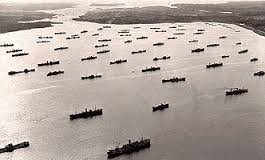The new year begins with a major change in your life. You begin active service as an Ordinary Seaman on HMCS Rideau, a River class destroyer. The Rideau is assigned to Atlantic convoy escort duties.
First Day on Ship - Clarence Mitchell
http://www.veterans.gc.ca/eng/remembrance/those-who-served/diaries-letters-stories/second-world-war/cmitchell
Before I was 18 years old, I found myself on HMCS Annapolis, an old 4 stacker destroyer given to Canada by the U.S.A. because Canada had hardly any fighting ships. The day I landed aboard with a bunch of other guys, young like me, the captain lined us up midship and gave us our welcome aboard address. He said now we can forget all that crap they taught us ashore. We were going to sea to fight a war, and he was not kidding. We grew from boys to men really fast.
Historical Note: The Canada/UK Convoys
There were two initial types of convoys that sailed from Canada:
HX, HG - faster convoys to Britain - sailing from Halifax - 10 days to cross the
Atlantic
SC - slow convoy - from Sydney, Cape Breton Island - 15 to 20 days
The Halifax Convoys - Clarence Mitchell

Bedford Basin in Halifax would have hundreds of ships ready to form a convoy. At dusk, the basin would be full and, by morning, the ships would all be gone. We would also be gone trying to keep the U-boats away from the freighters. That kept the Navy busy because the U-boats were everywhere. Halfway across the Atlantic was known as the Black Pit - too far for the bombers to fly out from Iceland, and the U-boats waited there in wolf packs. Many freighters and Navy ships were torpedoed there.
Here is a short video on convoy duty. Click on the link to view the video. At the end, click on the left or back arrow at the upper left corner of the screen.